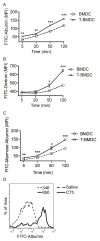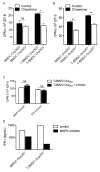Role of fatty-acid synthesis in dendritic cell generation and function
- PMID: 23536633
- PMCID: PMC3633656
- DOI: 10.4049/jimmunol.1202312
Role of fatty-acid synthesis in dendritic cell generation and function
Abstract
Dendritic cells (DC) are professional APCs that regulate innate and adaptive immunity. The role of fatty-acid synthesis in DC development and function is uncertain. We found that blockade of fatty-acid synthesis markedly decreases dendropoiesis in the liver and in primary and secondary lymphoid organs in mice. Human DC development from PBMC precursors was also diminished by blockade of fatty-acid synthesis. This was associated with higher rates of apoptosis in precursor cells and increased expression of cleaved caspase-3 and BCL-xL and downregulation of cyclin B1. Further, blockade of fatty-acid synthesis decreased DC expression of MHC class II, ICAM-1, B7-1, and B7-2 but increased their production of selected proinflammatory cytokines including IL-12 and MCP-1. Accordingly, inhibition of fatty-acid synthesis enhanced DC capacity to activate allogeneic as well as Ag-restricted CD4(+) and CD8(+) T cells and induce CTL responses. Further, blockade of fatty-acid synthesis increased DC expression of Notch ligands and enhanced their ability to activate NK cell immune phenotype and IFN-γ production. Because endoplasmic reticulum (ER) stress can augment the immunogenic function of APC, we postulated that this may account for the higher DC immunogenicity. We found that inhibition of fatty-acid synthesis resulted in elevated expression of numerous markers of ER stress in humans and mice and was associated with increased MAPK and Akt signaling. Further, lowering ER stress by 4-phenylbutyrate mitigated the enhanced immune stimulation associated with fatty-acid synthesis blockade. Our findings elucidate the role of fatty-acid synthesis in DC development and function and have implications to the design of DC vaccines for immunotherapy.
Figures








Similar articles
-
TLR8 stimulation enhances cetuximab-mediated natural killer cell lysis of head and neck cancer cells and dendritic cell cross-priming of EGFR-specific CD8+ T cells.Cancer Immunol Immunother. 2013 Aug;62(8):1347-57. doi: 10.1007/s00262-013-1437-3. Epub 2013 May 18. Cancer Immunol Immunother. 2013. PMID: 23685782 Free PMC article.
-
Macrophage-derived dendritic cells have strong Th1-polarizing potential mediated by beta-chemokines rather than IL-12.J Immunol. 2000 Oct 15;165(8):4388-96. doi: 10.4049/jimmunol.165.8.4388. J Immunol. 2000. PMID: 11035076
-
Isoflavones, genistein and daidzein, regulate mucosal immune response by suppressing dendritic cell function.PLoS One. 2012;7(10):e47979. doi: 10.1371/journal.pone.0047979. Epub 2012 Oct 22. PLoS One. 2012. PMID: 23110148 Free PMC article.
-
Third generation dendritic cell vaccines for tumor immunotherapy.Eur J Cell Biol. 2012 Jan;91(1):53-8. doi: 10.1016/j.ejcb.2011.01.012. Epub 2011 Mar 25. Eur J Cell Biol. 2012. PMID: 21439674 Review.
-
Killer dendritic cells and their potential for cancer immunotherapy.Cancer Immunol Immunother. 2010 Jan;59(1):1-11. doi: 10.1007/s00262-009-0736-1. Epub 2009 Jul 18. Cancer Immunol Immunother. 2010. PMID: 19618185 Free PMC article. Review.
Cited by
-
Innate αβ T Cells Mediate Antitumor Immunity by Orchestrating Immunogenic Macrophage Programming.Cancer Discov. 2019 Sep;9(9):1288-1305. doi: 10.1158/2159-8290.CD-19-0161. Epub 2019 Jul 2. Cancer Discov. 2019. PMID: 31266770 Free PMC article.
-
Role of Cellular Metabolism in Pulmonary Diseases.Am J Respir Cell Mol Biol. 2018 Jul;59(1):127-129. doi: 10.1165/rcmb.2018-0103RO. Am J Respir Cell Mol Biol. 2018. PMID: 29634283 Free PMC article. No abstract available.
-
A Comprehensive Map of the Monocyte-Derived Dendritic Cell Transcriptional Network Engaged upon Innate Sensing of HIV.Cell Rep. 2020 Jan 21;30(3):914-931.e9. doi: 10.1016/j.celrep.2019.12.054. Cell Rep. 2020. PMID: 31968263 Free PMC article.
-
Obesity alters monocyte developmental trajectories to enhance metastasis.J Exp Med. 2023 Aug 7;220(8):e20220509. doi: 10.1084/jem.20220509. Epub 2023 May 11. J Exp Med. 2023. PMID: 37166450 Free PMC article.
-
Long-chain acyl-CoA synthetase 4-mediated mitochondrial fatty acid metabolism and dendritic cell antigen presentation.Inflamm Res. 2024 May;73(5):819-839. doi: 10.1007/s00011-024-01868-7. Epub 2024 Mar 12. Inflamm Res. 2024. PMID: 38472395
References
-
- Steinman RM, Banchereau J. Taking dendritic cells into medicine. Nature. 2007;449:419–426. - PubMed
-
- Zeyda M, Saemann MD, Stuhlmeier KM, Mascher DG, Nowotny PN, Zlabinger GJ, Waldhausl W, Stulnig TM. Polyunsaturated fatty acids block dendritic cell activation and function independently of NF-kappaB activation. J Biol Chem. 2005;280:14293–14301. - PubMed
-
- Herber DL, Cao W, Nefedova Y, Novitskiy SV, Nagaraj S, Tyurin VA, Corzo A, Cho HI, Celis E, Lennox B, Knight SC, Padhya T, McCaffrey TV, McCaffrey JC, Antonia S, Fishman M, Ferris RL, Kagan VE, Gabrilovich DI. Lipid accumulation and dendritic cell dysfunction in cancer. Nat Med. 2010;16:880–886. - PMC - PubMed
-
- Miller G, Lahrs S, Pillarisetty VG, Shah AB, DeMatteo RP. Adenovirus infection enhances dendritic cell immunostimulatory properties and induces natural killer and T-cell-mediated tumor protection. Cancer Res. 2002;62:5260–5266. - PubMed
Publication types
MeSH terms
Substances
Grants and funding
LinkOut - more resources
Full Text Sources
Other Literature Sources
Research Materials
Miscellaneous

